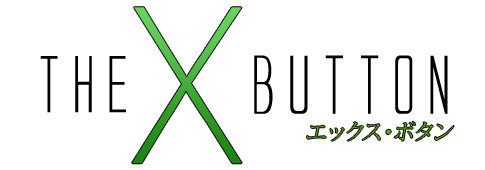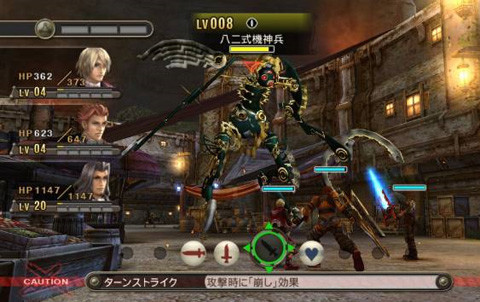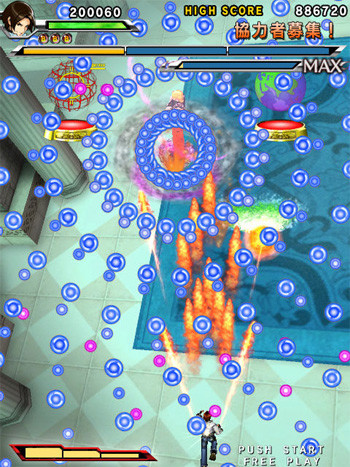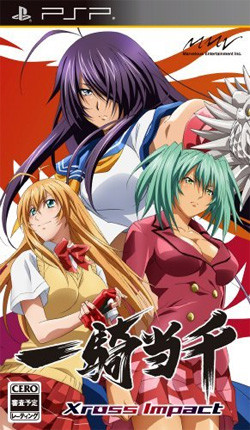The X Button
Wondering Heroes
by Todd Ciolek,

This month's import roundup includes an Ys game, which makes this a good time to point out that I find the Ys series bland and forgettable. But then I never got to know the Ys games in my youth, and I expect that a lot of today's Ys fans did. Even though I tried Ys III for the Super NES, it lacked the overhead viewpoint and generous anime cutscenes that defined Ys. If you wanted the real Ys, you needed to play Ys Book I and II, seen in North America only on the TurboGrafx system's CD peripheral. And I didn't know any kids who owned one of those. A friend who owned a regular TurboGrafx was rare enough.
So if I seem less than enthusiastic about Ys, you can blame my parents and my friends' parents for not buying us every expensive game console that we laid eyes on. Don't let this happen to your own children, anime fans of today.
NEWS
FIRST SCREENS OF THE LAST STORY EMERGE
Why should RPG fans care so much about The Last Story? Well, it's the next major project for Final Fantasy series creator Hironobu Sakaguchi and his Mistwalker studio, and it's showing up on the Wii, which isn't a haven for showy Japanese RPGs right now. It's also backed by Nintendo, and Nintendo can throw a decent budget behind its RPGs. And with Persona 5 undetailed and Final Fantasy XIII a relative disappointment, those who cling to the J-RPG genre need to look forward to something.

The first actual screens of The Last Story showed up this week, and they're promising even if they don't say too much. But hey, the game's world is far more down-to-earth in its medieval fantasy than, say, Arc Rise Fantasia, and its two main characters have some pretty impressive hair! Furthermore, it's established that the heroine is actually wearing more than the hero, thus rebelling against the usual J-RPG practice! All right, so little is known about the actual story, aside from the fact that it involves an island nation trying to throw off invaders by exploiting a magically empowered village.

Other shots depict the game's battle system, which requires characters to find protective circles on the field of play. Some circles heal and others allow special attacks, but all of them slow down the flow of combat and allow the player to enter commands. It's an interesting hybrid of real-time battles and player-controlled turns, and there's also a new method of interrupting enemy strikes. Glowing arrows show just where a foe is aiming an attack, and it's up to the player to keep enemies off of weaker party members. The game's director also mentions a system of “order and chaos,” which could mean just about anything.

Of course, we still don't know who that director is. Yasumi Matsuno confirmed via Twitter that he's not involved with the project, and people only suspected him because of the game's grimy medieval tone and his ties to Sakaguchi. I assume we'll find out our mystery director's identity before The Last Story hits Japan later this year.
XENOBLADE CHARACTERS REVEALED
The other major upcoming Wii RPG, Xenoblade isn't being nearly as stingy with its details as The Last Story. The Xenoblade website now has character profiles and other details about the game, which finds two warring races living on the giant corpses of fallen gods. The Homs race is, of course, a human equivalent, and they're joined on their home-corpse by at least two other species: the advanced humanoid Hienter and the egglike Nopon. The antagonists are known as the Kishin, and they're the buglike machines shown wreaking havoc in various Xenoblade trailers.

Three of the player-controlled characters can be seen at the website: Shulk is the ostensible hero, Fiorung is Shulk's childhood friend, and Dunban is Fiorung's older brother and an established warrior. Dunban once used the plastic-looking red Monado sword to fend off a Kishin invasion, but he's now too old (that's 30 in J-RPG terms) to control it, leaving Shulk to take up the mantle. The site features two “sub characters”: Shulk's surrogate dad Dikson, and Dunban's Wolverine-clawed rival Mumca. Famitsu recently announced even more characters: the swordsman Rein, the rifle-wielding Carna, the Hienter mage Melia, and the impish Nopon comedy-relief, Riki. The Monado sword is nearly a character itself, as it has a strange ability to destroy Kishin forces while not affecting anything else. Perhaps it'll play a significant role in Xenoblade's gameplay, the inner workings of which are still under wraps.
KING OF FIGHTERS: SKY STAGE HEADS TO PSP
The King of Fighters: Sky Stage seemed like a cheap spin-off when it was first announced, as it put only two characters from SNK's fighting franchise into a mundane-looking shooter. Since then, it's grown into a fairly prominent SNK release, jumping from arcades to Xbox Live and, most recently, the PSP. The King of Fighters: Sky Stage Ultimate Shooting includes the arcade version of the shooter, along with many other modes new to the PSP port. “Neo Geo Heroes” offers a branching selection of stages, along with several new characters. The original game features Kyo, Iori, Athena, Mai, Terry, and Kula from The King of Fighters, while Ultimate Shooting adds Marco from Metal Slug, Akari from The Last Blade, and, of course, the buxom maid Iroha from Samurai Shodown.

Sky Stage still resembles the typical modern 2-D shooter, what with the blue-and-pink bullets flying all around. Yet the fighting-game cast adds a unique attack system, as they unleash their special moves while darting between enemy fire. One wonders how a vertical shooter will fare on the PSP's horizontally longer screen, and we'll find out when the game hits Japan in July. I wouldn't rule out an American release, either.
IMPORT ROUNDUP: APRIL
KETSUI
 Developer: Cave
Developer: Cave
Publisher: Cave
Platform: Xbox 360
Players: 1-2
Well, all good things come to an end. Shooter fans and Xbox 360 owners have enjoyed region-free Japanese releases of Cave shooters ESPgaluda II and Mushihime-sama Futari, but Cave's given up that whole idea. Now North American geeks can't grab the long-delayed port of Ketsui and put it in an off-the-shelf Xbox 360. Outrage over this has been minor, possibly because Ketsui has sedate artwork instead of bug-riding schoolgirl princesses or fairy-winged revolutionaries who change sex in midair. Not that the shooter faithful will judge Ketsui by its somewhat generic looks. They'll judge it by the scoring system, the enemy patterns, and just how many red or blue bullets can fill the screen. Fortunately, Ketsui's an exact replica of the arcade version, plus a few extra modes. Lacking any major gimmick, Ketsui stands closer to Cave's Dodonpachi series in style: futuristic ships tear through the skies and similarly high-tech armadas, with destroyed enemies disgorging little numbered boxes. The closer you get to a foe before destroying it, the higher the number is. This inflates your score and makes you a better person in all walks of life.
Import Barrier: You'll need an Xbox 360 that can run Japanese games. Or you can get the region-free Ketsui Death Label for the DS, even if that's not exactly the same.
Chances of a Domestic Release: Better that you might think, now that Aksys Games is releasing Cave's Deathsmiles here later this year.
IKKI TOUSEN: XROSS IMPACT
 Developer: Marvelous
Developer: Marvelous
Publisher: Marvelous
Platform: Sony PSP
Players: 1-2
Would Ikki Tousen be better off as a video game than an ongoing series of comics and cartoons about high-school girls shredding their clothing? All of the buxom, fragilely dressed female characters and martial-arts ribaldry would be slightly more tolerable in a hyperviolent game, and Japan's filthy statue industry could still profit from it. What's more, it'd free up anime director Koichi Ohata to make that long-promised M.D. Geist III. Of course, there are still Ikki Tousen games, and the latest is Xcross Impact, a brawler in which 22 Ikki Tousen heroines high-kick their way through street punks, school thugs, and even other barely clad women. Players choose two characters and switch between them during combat, interrupted by occasional attempts at a storyline. In technical terms, the game looks decent, with large, detailed characters capturing the look of their anime inspiration. That look is often hidden behind huge images of warrior women falling out of their torn clothes, and there will be few complaints from Ikki Tousen fans here or in Japan. Those same fans may also be interested in the game's two new faces: the scheming Ato and the unassuming Chinkyui, neither of whom wears battle-ready attire.
Import Barrier: Not much, as long as players skip the dialogue. And they will.
Chances of a Domestic Release: Valcon Games canceled a domestic release of Ikki Tousen: Shining Dragon for the PlayStation after the game earned an M rating, and no North American publishers have touched the franchise since then.
YS: THE OATH IN FELGHANA
 Developer: Falcom
Developer: Falcom
Publisher: Falcom
Platform: PSP
Players: 1
A.k.a.: Ys: Felghana no Chikai
Ys III: Wanderers from Ys was the black sheep of the first four Ys games. The other titles are action/RPGs with overhead perspectives, but Ys III is a side-scrolling game where Adol, in contravention of Ys tradition, actually swings his sword at enemies instead of running into them. Ys III was not remembered fondly, but for many American kids who owned only a Genesis or a Super NES, Ys III was all they really saw of the series. Back in 2005, Falcom decided to remake Ys III into the game it probably should've been fifteen years prior. The Oath in Felghana is an overhead action/RPG like just about every other Ys game, and it expands upon the original with a time attack mode and a larger story about adventurer Adol staring down yet another ancient evil force. The recently released PSP version of the game is bundled with a special-edition drama CD, a reminder of the days when Ys games and soundtracks ruled their own corner of Japan's Game and Anime Empire. Now they're just some old franchise in a retirement home, playing checkers with Tengai Makyo and Breath of Fire.
Import Barrier: It's a straightforward game, but you'll need to understand some of the dialogue.
Chances of a Domestic Release: Ys VII is all but confirmed for a U.S. release, so there's a slim chance that The Oath in Felghana will follow it.
NEXT WEEK'S RELEASES
MONSTER RACERS Developer: Tecmo/Koei
Developer: Tecmo/KoeiPublisher: UFO Interactive Platform: DS Players: 1-4 MSRP: $29.99 Monster Rancher finished third in the creature-collecting anime craze of the late 1990s, falling shy of Digimon's popularity and never even touching Pokemon. Yet Monster Rancher is still around and still getting spin-offs like Monster Racers, so that must count for something. Far from a cheap Mario Kart retread, Monster Racers is a creature-raising simulator where side-scrolling marathons take the place of traditional battles. Players hunt down creatures, train them, and then turn them loose in 2-D stages alongside various other Monster Rancher beasts. There's a multiplayer WiFi mode, plus a tournament mode and the now-traditional choice of a male or female player-avatar, each with an allegedly distinct “storyline.” The game's assortment of 80-plus creatures doesn't seem to have any of the original Monster Rancher characters, so you can forget about Monster Racers resolving those long-unanswered questions posed by the anime series back in 2000.
|
EXTRA LIVES: MACROSS
 Anime fans will forever remember Robotech as a titan of '80s cartoons, but it was more that just three anime series smashed together. Through the merchandizing wonders of that decade, Robotech had its own toy lines, RPG books, novels, and even, in scarce form, a movie. Yet one area of pop-culture licensing remained untouched by Robotech: video games. Robotech games wouldn't emerge until the decade was over, even though a suitable NES game existed in the form of a Super Dimension Fortress Macross shooter.
Anime fans will forever remember Robotech as a titan of '80s cartoons, but it was more that just three anime series smashed together. Through the merchandizing wonders of that decade, Robotech had its own toy lines, RPG books, novels, and even, in scarce form, a movie. Yet one area of pop-culture licensing remained untouched by Robotech: video games. Robotech games wouldn't emerge until the decade was over, even though a suitable NES game existed in the form of a Super Dimension Fortress Macross shooter.
This particular Macross game emerged on the Famicom in 1985, roughly a year before the system would come to America as the NES. As an early Famicom title based on an anime series, it does its best to evoke the air of its license without any attempt at plot: a Minmay doll bangs a gong, and then you're hurling through space in a transforming valkyrie fighter, circular explosions dotting the starfield behind you. Even in this basic Macross shooter, the designers were careful to include the valkyrie's three modes. The jet fighter rushes across the battlefield, but it fires relatively slowly. The gerwalk mode slows down the speed of the game, but it shoots rapidly. The battroid also moves even slower, but it can fire quickly in two directions. And, because the NES and Famicom had only two action buttons, players have to push select to launch a limited burst of the valkyrie's missiles.
 The Macross shooter begins with a simple run through a space battle. Zentraedi fighters and battle pods swoop your way, often flying straight past without noticing you. Weathering these attacks, you come to the hull of a Zentraedi battleship. Inside, you endure a few more phalanxes of enemies before taking on the ship's core. It's soon destroyed, and you're off to the next level.
The Macross shooter begins with a simple run through a space battle. Zentraedi fighters and battle pods swoop your way, often flying straight past without noticing you. Weathering these attacks, you come to the hull of a Zentraedi battleship. Inside, you endure a few more phalanxes of enemies before taking on the ship's core. It's soon destroyed, and you're off to the next level.
Now, Macross was primarily a space opera, but it has plenty of opportunities for new scenery. Surely the next stage will show the bleak landscapes of a destroyed Earth, the city interiors of the SDF-1, or perhaps a run through the weird organic Zentraedi fortress that looked so imposing in Macross: Do You Remember Love?
Suckers. The next level is exactly like the first, except with floating mines. It has the same background, the same three types of enemies, the same goal, the same length, and the same grating 8-bit version of Minmay's “Little White Dragon” looping constantly. Later levels make the bold move of adding in Zentraedi mecha suits and battleship turrets, but the game's still a chore by the third stage. It wouldn't be all that bad if it had some variety: the graphics are serviceable for a first-generation NES game, and the controls respond slightly better than those in early Famicom anime adaptations like Fist of the North Star, Zeta Gundam, or Chubby Cherub.
 Harmony Gold and its business partners could've turned Super Dimension Fortress Macross into a Robotech shooter just in time for the 1986 debut of the NES. Change the title screen, pipe in some less repetitive music, and you'd have a Robotech game for kids to play just after they'd finished watching syndicated Robotech reruns or commercials for the “Women of Robotech” line of dolls.
Harmony Gold and its business partners could've turned Super Dimension Fortress Macross into a Robotech shooter just in time for the 1986 debut of the NES. Change the title screen, pipe in some less repetitive music, and you'd have a Robotech game for kids to play just after they'd finished watching syndicated Robotech reruns or commercials for the “Women of Robotech” line of dolls.
Yet no one bothered bringing a Macross shooter to the States back then, and it was all for the best. Without some serious re-working, this early Famicom game would've only disappointed young Robotech fans. They'd spend their birthday money on it, get bored after 48 seconds, and then perhaps bitterly defend the game to friends before admitting the ugly truth of it. We should thank the architects of Robotech for preventing all of that.
The Super Dimension Fortress Macross is relatively common among Famicom games, and copies can get as cheap as five bucks at auction sites. Fans might be more interested in the packaging, as it has some unique Macross artwork.
discuss this in the forum (14 posts) |
this article has been modified since it was originally posted; see change history